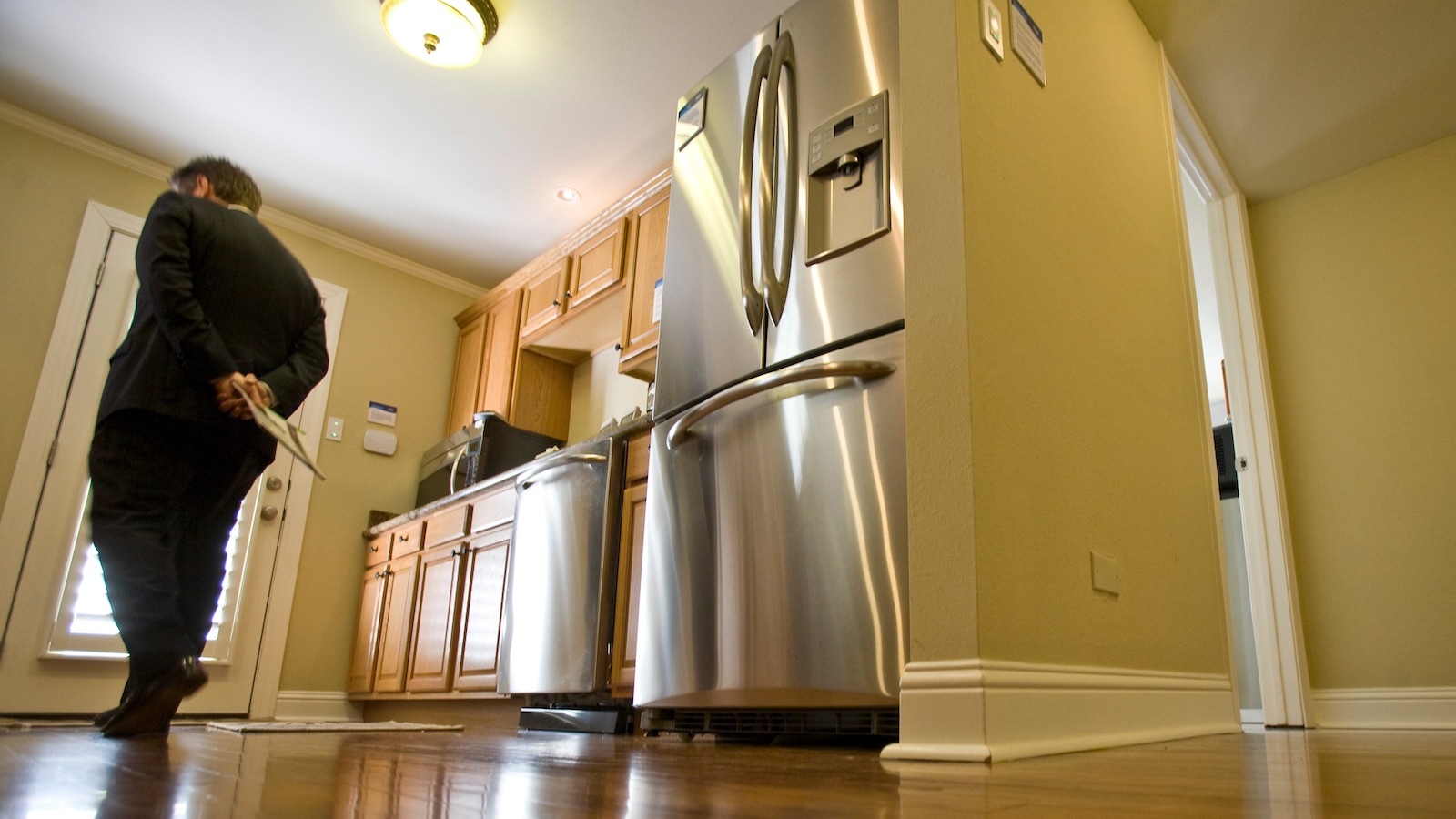Two things here. I was forced to go induction when I moved house about fifteen years ago, and I love it. It’s just better than gas. I’m terrible at many things, but I’m a good cook, and I can say, there’s nothing I can do - nothing - that isn’t better on induction. Admittedly, not crazy about the waste of new things, but even so, worth it.
Also, turns out, Big Natural Gas lied to you. It’s dangerous (which the article states). This is a carrot and stick. I’m all electric, and working on solar soon.
Agreee, and a third thing. Gas usage for cooking is so small, it’s really a non-issue.
Gas usage for heating is the big one we need to curtail. Having a culture war on cooking ranges is a distraction.
It’s not a distraction so much as it’s the bait. Gas cooking gets the utility serviced to the building, which enables the gas furnace vs electric heat pump conversation. Gas furnace is cheaper up front, so that’s what goes into suburbia.
Builders and developers will always do the absolutely cheapest thing possible to stay competitive, and will only do better when they’re either legislated to or consumers demand it. Home builders associations lobby to keep minimum requirements … minimal, and most consumers just see pretty showers and big kitchen islands, so this is why we still build houses like it’s 1980.
Always amuses me how many people care about gas mileage on a $50k car but couldn’t give two shits if their $2m home is efficient.
Source: I’m a home designer who frequently has this conversation and that’s usually how it goes down.
Then you are living in an area that is running a bit behind.
Once you electrify heating, no one is going to pay for a gas line in new construction.
We (Netherlands) had these conversations go down like this 5 years ago. Now, no new home construction is running a gas line.
Canada, and yeah when it comes to how we build we are definitely behind. Oil and gas is so entrenched in the economy, especially western provinces, that any going against that is blasphemy to a significant chunk of the population. It will get better though. We can already do better, the incentive just isn’t there.
I’m a certified passive house designer and I’m always jealous of all the products and materials available in Europe!
Do you guys all have fireplaces and generators?
No, our electric grid has been extremely reliable.
I couldn’t trust that, and it only gets to like -11F around here.
If you don’t have reliable electricity, then get a generator or wood stove.
That’s what rural folk do all around the world.
Wood stove as backup is pretty common in some parts of the US anyways. Heat pump + wood stove = not much physical labor + cheap to operate + backup heat for ice storms
Removed by mod
the issue about it being literally poisonous for humans is kind of a big deal, regardless of how much gas you use. Domestic range hoods do FA.
If you want to keep your gas stove despite the very real health implications, that is a poor choice.
Agreed on both points. As a trial we got a cheap induction hot plate and really like it. We also learned that we want a range that doesn’t have a noisy fan and has a continuous very low setting.
Those Ikea induction hot plates are really nice and a great way to try induction cooking.
I strongly recommend getting one that’s just a touch fancier, and which has a thermostat in it. This lets you set the temperature of the pot so that you can fry without making the oil smoke.
deleted by creator
If your pans are taking time to heat up, you probably had resistive plates, not induction. Induction is FAST - fast to heat up, but also fast to cool down. It’s very similar to cooking on gas.
They probably had glass-ceramic. A lot of people confuse those for induction, since they basically look the same when it’s off: a black glass plate.
When it’s on, the glass-ceramic lights up and becomes red or purple, while induction stays black.
Induction is faster than gas. I have never met anyone who prefers gas to induction after using induction for a while.
Buying an induction cooker has made cooking in apartments with shitty coils so much better, I don’t even want gas in the future anymore. We’re considering getting a cover for the range and just buying 2 more induction tops
Try curved induction plate. Wok doesn’t work with flat induction plates because the moment you start moving it, you’re not heating it anymore.
Induction is objectively superior in heating speed and heat control. But if your cooking technique doesn’t work with it, the previous statement is meaningless.
If your cooking technique involves flipping rice past the flame so oil catches fire a little, then gas is the only option.
Well, firewood too :)
Now I want to try smoky fried rice.
this is why big gas is cranking up the propaganda on stoves. induction stoves are better, don’t believe them
Why are they better?
Pollution and home safety aside. I found it nice to pinpoint my desired heat. It works so fast and accurate that I got consistent pancakes like i never used to before.
That’s pretty cool. Can they heat a pan as fast as a gas stove? One of the major inconveniences with an electric stove is having to wait for the burner to heat up, before you can wait for your pan to heat up. I’ve had resistive stoves for decades now, and they’re not very good IMO. But I’ve never had an induction stove. I’ve really missed the gas stove we had when I was a kid.
Simple answer: yes, induction hobs are fast, maybe even faster than gas.
That’s really cool.
Back on gas after having induction (moved).
I also grew up on resistive and was as skeptical as you are. Now, I dream about upgrading to induction again once we are able to reno the kitchen. For example, boiling water on induction is more than twice as fast as gas and the temp adjustment goes so quick that even cooking eggs is a breeze.
Yeah, when I fry eggs the pan heats up to temperature in literally seconds - not a half a minute, but like 5 to 10 seconds.
Removed by mod
You can imagine an induction stove to work similarly to a resistive stove, only with your pan/pot being the resistive element. The slow part of resistive stoves is the heat transfer from the element to the cookware, so you can imagine how quickly an inductive stove heats that thing up!
it’s noticeably faster than a gas stove. plus the neat thing is it’s not giving you and your family cancer!
They don’t require an explosive to be pumped into your house.
That’s not really the type of information I was looking for, but thanks anyways.
Gas stoves also emit stuff like benzene, which has been linked to cancer, and NO2 which has been linked to asthma.
But ignoring the health issues, induction is faster for boiling stuff, and arguably more precise. You likely don’t need new pans either. Flat bottom, cast iron works fine and stainless works fine for me.
It just takes some getting used to.
You have special stainless then, most won’t work.
If you can stick a magnet to the bottom it will work.
I mean, I bought the set in aldi. It was in the bargain bin for something like 60 euros for 10 pots and pans. Was worried it wouldn’t work when I moved. Tried it. Worked just fine. Apparently plenty of stainless steel stuff works just fine.
This isn’t particularly interesting.
But just to say, before buying new expensive ones that claim to be designed for induction, try the old ones you already own. Chances are they’ll work just fine.
Removed by mod
While I don’t agree they’re better, a key feature over conventional electric (and one of the main benefits of gas) is that the stove surface doesn’t inherently retain heat. They get hot, but only because the pan is hot. When you turn down the heat, it’s immediate, like a gas stove.
I don’t know about how fast they can heat; gas can output a ridiculous amount of BTUs, but at 240v I wouldn’t be surprised.
Have to keep efficiency in mind as well. Practically all of the heat produced by induction goes directly into the pan bottom. With gas, quite a bit of the heat doesn’t end up in the pan.
In my experience, induction on high settings heats much faster than gas. Sometimes faster than is desirable actually. A pot of water will boil at the bottom when the top is only somewhat warm.
I don’t know about the US, but in Germany it’s common that the individual or two plates of the induction stoves have their own 380V cable and breaker.
North America has one 240v plug for the whole appliance, 120v is what’s used for regular electric items.
The US often has some appliances wired for 240V; I assume stovetops are, but IDK. Large appliances have their own breakers. I was told that if we wanted to install a built-in microwave, it’d require a new, dedicated wire and breaker.
A lot of places have code requirements that the microwave have its own breaker even though they’re almost all 120v; it’s because they use almost all the amps on the 120v circuit so you tend to trip the breaker if you have anything else big going on, like an electric kettle or a vacuum cleaner.
Yeah, in the US for an electric range you’re looking at a single 240 volt split phase 30 amp circuit.
Better air quality, otherwise they are merely not as inconvenient as other types of electric stoves.
But you need to buy new induction capable pots for them and the pulsing heat they make takes some time to get used to.
AFIAK they also work with cast iron cookware.
Any ferrous metal. Right? So anything except stainless steel. I’m guessing you probably want something fairly thick too.
Stainless often works too IME.
Yes, very thick otherwise you get a burn spot everytime around the middle.
Also, my stainless pan works fine on my induction stove.
Does it have a fused base of other metals?
Yes, aluminium “Sleek Seamless Impact Bonded Sandwich Base with Aluminium Core”
That may be it, I’m not sure I bought it at a thrift store.
Enamel and aluminum are the only ones I’ve had issues with, personally.
What they do now is “sanwchich” with a disc of induction-compatible metal inserted in the bottom of the cookware.
Allows compatibility (and better heat spread I think)
From experience, they work as long as a magnet can stick to it, so yes flany ferrous metal should work.
Induction is the best cooking method to me. Faster and safer than electric and gas, (much) easier to control than electric…
Ah and so much easier to clean than gas!
Only gas advantage I could see is maybe heat “fine tuning”. And even this probably depend on the system (the one I used had roughly 6 heating level, but there is system with more). And is not very important except if you’re a high level chef.
You don’t necessarily need to buy new pots as the ones you have might as well already be ferrous.
I’m still using my old cast iron cookware.
The pots that did need replacing when I went from coils to induction were a set of very cheap stainless steel ones that I bought when I was a student.
That’s mainly an issue with aluminum and stainless steel, but only some types of stainless steel. It’s a good stuff that I have all works flawlessly on the induction.
If you buy the aluminum Japanese cookware, they are all designed for induction anyways.
Instantaneous control over temperature without the safety issues of gas
In addition to the other comments about it being just as quick, if not faster and easier to get a consistent heat, I also found the noise level was way better - it’ll hum if the pan isn’t centered properly, and the power is turned up, but when simmering, it’s pretty much silent which was weird but suprisingly nice.
Safer, cheaper, cleaner.
Safer being no indoor air pollution and to cook surface doesn’t get hot at all. You can literally put a piece of paper between the pan and the cooktop and it will cook without burning the paper.
no open flame
I didn’t have a gas stove until I was in my late 40’s. I will not willingly go back to conventional electric. Gas stoves are better. Finer control, faster temp changes (esp. when decreasing).
I’d be willing to try an induction stove. They’re rare in the US, but my limited experience with them was positive. Not quite as nice as a gas stove, but miles better than an conventional electric range, and good enough that the easier cleaning would tip me over.
You mention propeganda; it’s odd that the only propeganda I encounter is the anti-gas kind. It’s non-stop on NPR and social media. I haven’t heard or read a single pro-gas piece.
Edit: I think you were only talking about induction, so I changed some phrasing.
Gas stoves are better. Finer control, faster temp changes (esp. when decreasing).
Gas stoves are better in some ways, but “finer control” is debatable. If you turn the knob from 0 to 10, it’s obvious that the energy output is non-linear. On my stove the flame has like 50% of its increase between level 2 and 3 or 4. You also have a more narrow range of heat with gas. That is, the lowest setting has to be high enough that the flame does not blow out, so the min heat is higher than the min level on electric. Electric also gets hotter than gas on the high end.
With electric you get precise control. Power level 5 gives exactly half the heat energy that 10 gives; power level 6 is exactly triple the heat of power level 2. You don’t get that precision with gas. You can only eye-ball it which means harder to get reproduceable results.
You probably meant to say gas gives you /immediate/ control. Conventional electric is quite slow, but induction is fast.
Maybe it’s a brand or quality difference; I can pretty finely control the flame on our range.
“Control” is the ability to adjust to a desired temp with fine accuracy, right? I can see the flame, and observe changes more rapidly, with gas. Isn’t this finer-grained control?
A common residential electric range outputs a max 7,000 BTUs. A common gas stove outputs max 18,000 BTUs. Electric stoves are not hotter on the high end.
Gas stoves lose a majority of those BTUs to the air around your pot.
A 18,000 BTU stove should be equivalent to 5300W of electric heating, alas, my 1500W kettle boils water substantially faster than my gas stove
“Control” is the ability to adjust to a desired temp with fine accuracy, right? I can see the flame, and observe changes more rapidly, with gas. Isn’t this finer-grained control?
You’re eye-balling it, so you have good control over what your eyeball sees, but then that mental image has to lead to a judgement. Imagine if you were doing a scientific experiment where you need reproducible results and the amount of heat energy were important to the experiment. Would you write in the scientific paper “the flame looked like about 1cm with each sample tested”? You could meter the gas but the heat losses are higher as the flame grows because you’re heating increasingly more of the air around the pan.
A common residential electric range outputs a max 7,000 BTUs. A common gas stove outputs max 18,000 BTUs. Electric stoves are not hotter on the high end.
Gas stoves probably lose half their energy by heating the air all around the pot so you have to account for that. With electric much more of the BTUs actually make it to the food (esp. induction). When I search around, articles out in the wild are all over the place… some saying electric coils get hotter than gas and some saying the contrary. One article concurs with you, saying a gas burner reaches 1950°C and electric 900°C. I don’t see any articles mentioning electric burners that get into the four figures among those that actually give temperature figures so perhaps you’re right. But it’s worth noting that a pot of water boils faster on electric than gas.
You’re eye-balling it
You’re right. I’m not a scientist. I’m not even a professional chef. What matters to me (and most American homeowners, which is who the article is the granular control available to me. I don’t much care what’s possible in a lab. It’s at least part of the reason why, as the article states, many of us are unwilling to give up the control we get with gas.
Gas stoves probably lose half their energy by heating the air all around the pot
I’ve seen that, too. I don’t believe it’s accurate (I’d like to see an unbiased verification of that 50% number), and it misses another advantage of gas: gas heats pots more evenly by distributing some heat up the sides. Elecric heats only the bottom directly, and sides are heated only through conduction. It also means that less of that heat is wasted: just because it isn’t hitting the bottom of the pot doesn’t mean it isn’t doing useful work. This also only considers pots. Pans usually have greater coverage of tye heating surface, and less heat escapes around the sides. This is relevant especially where high heat matters, such as searing. Finally, there are pots like my wok, which has a base that entirely covers the grill. It has holes, so it breathes, but it captures nearly all of the heat. Woks are particularly bad on conventional ranges, and having an electric range essentially eliminates woks as a viable tool.
As I think more about this, the more disadvantages of electric I see. Sauteing is better on gas. You can manipulate a pan, lift and tilt, and have many more options than simply having or not having applied heat.
I can see having a range with a few induction spots; most dishes don’t need the fine control; boiling water, cooking pasta, and steaming vegetables are all gross operations, but I’d still want at least one gas surface. It’s just better for anything that isn’t boiled food.
I’m not a scientist. I’m not even a professional chef. I’m an average American homeowner and when we replace our gas range and oven we’ll get an electric oven and an induction range.
Having used gas, electric and induction my experience has been that induction cook tops are the safest and provide the greatest temperature control of them all. The biggest drawback is the requirement of specialized pans but we switched to clad stainless a few years ago to get away from the non-stick chemicals risk.
I’d say this comes down to cost and familiarity. People are used to gas stoves and are likely wary of change. Combine that with the fact that many homes are setup for gas ovens, with no electrical plugs for a switch and you’ve got several costs to change. The new oven itself, getting an appropriate outlet wired in, and for induction, changing pans to something that will work.
The other consideration is that gas continues to work in an electrical outage, however, I’d imagine many ovens are electronically controlled. I know our gas stove will not work without electricity.
😄 Our oven is electric. It’s the only thing I lament - it takes forever to come up to temp.
I’m in my mid-50’s, and this is our first house that’s had gas, so for me it’s definitely not a case of familiarity. My whole life I’ve had electric, and having a gas range has been a game-changer for me.
That said, I’ve also never seen, and certaily never lived with, an induction range. I do miss the cleaning conveniance of a glass-top - cleaning a gas range is a PITA! And induction has as good immediate temp reduction response as gas, which is a large factor in control. As I mentioned earlier, I’d never willingly go back to conventional electric, but I might opt for induction just for the ease of cleaning. I can live with not being able to properly saute, but giving up the wok would be hard. Still, it’s something to consider.
Two other things: except for our ovens (an odd omission), the rest of our house is gas. Water heaters, fireplace, clothes dryer, heat. None of it works without electricity, although in a pinch I can light the stove with a match. The fireplace can’t be lit - there’s a safety switch that needs current, which could be run with a battery-operated part we don’t have. It’s the most stupid thing about our house - we can’t get any heat in a power outage, despite all the gas. So, of everything, running the stove in a blackout is funnily enough the least of my concerns.
Does your gas not run in an outage, or can you just not start it? If the gas runs, you should be able to light it with a match. OTOH, you can’t run the ventilation fan, and that might put you off running it anyway.
I haven’t heard or read a single pro-gas piece.
Right-wing media apparently. Not American, but from what I gather if you watch NPR, you’re a communist and a homosexual. So that means you won’t be watching real American media like Fox News.
Stuff like this from a member of congress:
“I’ll NEVER give up my gas stove. If the maniacs in the White House come for my stove, they can pry it from my cold dead hands. COME AND TAKE IT!!”
https://twitter.com/RonnyJacksonTX/status/1612839703018934274?t=ptxUxaAhqE1ax8FwY15cyA
Idk why “watch NPR” is so funny to me right now lmao
I’m so sleep deprived
from what I gather if you watch NPR, you’re a communist and a homosexual.
Cmon, I’m not impressed by your knowledge. This is written in the first paragraph of the constitution.
GF was a professional cook for 15 years, still prefers our induction stove to the gas stoves she worked on all this time.
Yeah, I can believe I could learn to prefer induction. They’re just incredibly rare in residential US homes, which is where I live, and what the article was about.
The only place I’ve encountered an induction stove was in the EU, where - I gather - they’re more common.
They’re starting to become more widespread in the US as people understand the health risks that come with gas stoves.
This here shows where the propaganda appears:
When people think of electric stoves, they think of resistance not induction. If people had more experience with induction, I’m sure they’d be less resistant to the change.
But this is America, they still use checks…
They’re so controlled by their corporations.Give me a digital transaction without fees and I’ll give up checks. They cost less to accept.
Lulz, fees on digital transactions, is it the 90s again?
When I accept digital payments for my professional work there is always a fee no less than 1% and sometimes as high as 3.75%. Is your experience different?
I think they’re making fun of the US for still having fees.
Here in europe bank transfers are generally free.
Point scored for Europe. I wish that was the case here. I use a service that will do ACH transactions (account to account) for about 1% but many people only want to pay with cards and that means 2.75% or more. Banks suck.
Yeah so over here you would lose more from clients not doing business with you because your prefer checks than what it would cost to pay the fees, but I thought you meant transaction fees for the person paying, not for the business. Debit is much less expensive than credit too so some businesses just don’t accept credit (but it’s getting rare).
Mostly I do accept the digital payments. Very few, particularly since the pandemic, pay with checks. But it hurts a bit when its accounting time to pay those big fees. Its just profiteering because they can do it as a group of monopolists.
induction is nice, and the old school induction are fine if all you do is casual cooking. there’s no reason to give big gas more dependence
Old school resistance you mean
Just picked new appliances for our house. I wanted to look at induction but the ones that were within budget had some questionable reliability in the reviews. However we made sure we have the beefy outlet so we can upgrade as the price comes down. I miss cooking with gas but new electric stoves and some good pans are not that bad. It’ll hold us over until upgrade time… I hope.
I tried induction using a plugin electric one burner mini appliance. Its not even the whole real thing and its a great experience.
In my experience both have their upside and downside. I only ever use my resistance stove to braising or stewing, anything that require simmering for long hour, as it provide a consistent heat throughout the cooking process.
Are you saying induction doesn’t provide consistent heat for long periods? Because resistance is the one that doesn’t (at high temp anyway) with the element being turned on and off again and again…
Induction directly heat the cookware so the heat really only coming from the cookware itself, if the cookware isn’t thick enough it will conduct the heat away quickly, or if i turn it on high it will quickly burn the bottom of whatever i’m cooking. It still have to cycle on and off to control the heat though.
Electric stove on the other hand heat the metal coil/ceramic surface so the heat can conduct into the cookware. This way i can have a surface that is consistenly around that temperature, making it easier to control the heat if i want it low enough to simmer but not boil.
In my experience, it’s easier to get my food burn with induction because of the direct heating of the cookware. Maybe yours have those fancy-mancy setting to prevent that, but i don’t have that sort of setting unfortunately.
I think it’s more about experience with it, you can’t cook like you would with a resistance stove… We just made 10L of spaghetti sauce and it was on our induction stove for 6 hours without burning… You just have to get used to adjustments being pretty much instantaneous.
Honestly, maybe it’s my stove. Its a cheaper one as budget is tight. Ohh well, at least i found a balance with it.
This should be required watching for every moron who claims gas is better.
If you need that instant temperature drop, remove it from the heat??
Also, induction is even better. Hopefully they become affordable and not priced like fancy appliances in the next decade.
The main advantage for gas isn’t speed, it’s control. I have both gas and electric, standard halogen etc type stoves are junk compared to the fine (also instant, consistent, and reliably easy to gauge) control that gas hobs provide. Not to mention a very even heat . But I agree modern induction finally provide that similar level of control (though the one induction hob I’ve used, while excellent granular control, did seem to heat unevenly requiring the pan to be regularly turned to avoid one-sided burning).
did seem to heat unevenly requiring the pan to be regularly turned to avoid one-sided burning).
That’s due to the heating area being incredibly tiny on various crappy induction stoves.
I’ve had a different experience with gas stoves… many of the standard ones can’t be turned down low enough. Simmering something or just keeping it warm is a challenge because there’s too much flame. Really easy to burn sauces or hard to keep them from boiling after they’re done and you just want them to stay warm.
When shopping for appliances for a new house a few years ago I had to pay quite a bit extra to get a higher-end gas stove that had a dual ring of burners that could be turned down lower. In retrospect I wish I’d simply went electric.
Induction is better in every way, like power output, heating speed, and control, except being able to lift the pan freely wok style. Cooking with gas indoors is totally stupid.
Better in every way is nonsense. Cooking indoors is only stupid for morons that don’t know how to safely use a gas stove top. There’s a reason most professional kitchens still use gas and haven’t all rushed to replace with induction - the benefits don’t outweigh the investment.
@glencairn84 @jol safely as in…? Properly ventilating the kitchen in the middle of a cold winter?
It’s cheaper to operate and repair gas stoves. That’s why professional kitchens still use them. But you don’t operate a professional kitchen. You cook twice a day at most.
IKEA has induction cooktops for like $600 or 700 bucks. They’re made by Frigidaire and are backed by a 5-year warranty… If you buy from home Depot that same Frigidaire cooked up, you could only get a 1-year warranty. Otherwise it’s the same exact product.
Okay, the price went up a little bit:
https://www.ikea.com/us/en/p/saerklassig-induction-cooktop-black-20462066/
Are induction stove tops still expensive where you live? I just bought one used from a colleague at work and will wire it up today. I haven’t really tried to get a good overview of the market since I didn’t buy a new one, but I got the feeling that it doesn’t exactly come with a hefty price tag nowadays.
I’ve been using a standalone portable induction system whenever I didn’t need 2 or more pots/pans at the same time, so I have some experience how neat the technology is. The fact that it wastes no energy going past the pot (like gas), doesn’t require a perfectly sized pot to maximize efficiency and reacts instantly to changes when I turn the knobs made it a very desirable purchase for me. And the fact that it’s a fast way to heat your food. I doubt that I’ll be using my water kettle to pre-heat my pasta water anymore.
Heat storage effect -as soon as you put anything in cold in the pan the whole element goes cold and it takes ages to reheat. Unlike a gas flame.
And “induction” heating is 90% conduction - only a tiny part of the pan is inducted and then the heat has to conduct to the rest of the pan. So in some ways its worse than a conventional electric hob because the heating is so uneven, and you still get the heat storage effect.
No it’s not. Buy a decent one and they work really well. I’ve never had any issues with hotspots.
Induction is great, switch 1 yr ago. Most cookware works, not just cast iron.
Pro tip: if want to know if your pan works with induction, take a magnet and see if it sticks to the pan. If it sticks, it will heat!
Some non-magnetic cookware can still be used on induction heaters
Lazy tip: get the induction thing. See which pans still work before buying anything new.
Removed by mod
People here seem unaware that there exists a 3rd option that isn’t either gas or induction - a ceramic hob is electric, heated coils under glass, but you can use it with any pot or pan, so there’s no need to spend all that extra money replacing all your cookware, and the hob itself is cheaper too.
And they’re terrible at cooking: any change in temperature, including heating up takes a ton.
They’ve served me perfectly well for over a decade.
The difference in supposed quality wouldn’t be noticeable to most while the difference in cost definitely would be. ¯_(ツ)_/¯How much do you pay for electricity?
Because with an induction stove you’ll be paying 30% less in cooking costs.
I like my 2012 electric stove. I don’t notice any difference in cooking experience when I use my parents’ gas stove at their place, except the flames require more aggressive ventilation
Not unaware, just not mentioning it as an option because it’s so inferior.
I got an induction system yesterday and ripped my old ceramic one out. I mean, it worked okay apart from the fact that it was slower and would take a while to cool down again.
What always bothered me was not always having the ideally sized one and seeing all the red glow around the bottom of the pot or pan. “Fuck, I’m wasting 30 % energy right now…”
How many tons of co2/methane are emitted annually from residential ovens and ranges?
I feel like this number is small and am curious if anyone has chased this rabbit.
https://pubs.acs.org/doi/10.1021/acs.est.0c00437
Electrifying everything but the gas stove means keeping the entire gas distribution system, which leaks like a sieve.
Well why are they building them out of sieves?
Propane tanks too? Or so you mean the methane pipes?
The article I linked is about methane but, as someone who is on propane, I can pretty much guarantee it’s not much better. I don’t know if you’ve ever been around a propane fill-up, but the connection/disconnect process breaks of the odorant - it definitely has a loss on every transfer.
The only good news is the emissions factor for propane is much lower than methane
I have a propane tank for my range. I’ve only had it for 3 years and haven’t needed to fill it yet.
I cut our gas line 2 years ago from our house! Feels good. Also didn’t want to have to invest in a seismic shut off gas valve.
And the heat pump gives us air conditioning, which is a win-win.
Spent the first 1/3 of adult life with gas and the latter 2/3 with electric. It’s not hard to adapt cooking methods. Food still comes out just fine. It also makes one more adept at cooking when say, traveling and having to use who knows what terrible stove/cooking object.
I’d much rather figure out how to adapt to an electric cooking device that I could 100% self-power if need be, than continue to use an explosive cooking device pumping chemicals I don’t want into my home because the natural gas companies don’t processed the gas to remove them.
Gas had a place in homes in the 19th and early 20th century when we didn’t know better, not anymore.
What do you mean by self power? Cause you’re not using an exercise bike to power it. You wouldn’t even get close.
I love induction, myself, but if you need a flame, there’s countertop burners to help with the transition. No need to pipe gas through the whole city. There was just a gas explosion in an empty house (two days after closing!) down the road from us.
Apparently this is one of the big reasons gas is so popular in restaurants. No need to pipe gas or put in higher voltage electricity. Just attach a gas bottle.
There is a lot of tall about everyone replacing their stoves but it’s expensive and really not needed. You can do 90% of your meals with counter top appliances and be good to go.
We have the following: portable induction cooktop top, 6 and 3 qt instapot, 5qt air fryer, and electric hot water kettle. These devices are used nearly everyday and if we need to use the gas stove we do, but it’s pretty rare.
When the kitchen is renovated, an induction stove will be purchased, but for the last 5 years our counter top chefs have been great.
I bought a replacement induction cooktop last year and it’s an absolute game changer, but we went from an old crappy electric cooktop that was just awful.
Any Asians, specifically Chinese in here with induction stoves to give us a feedback? How does it work with thin steel woks?
I’ve not used one myself but my workplace cafeteria occasionally does made-to-order wok lunches where they pull out induction woks where the induction surface is parabolic so the wok can have the proper wok shape (not a flat bottom). When they crank the heat up, it’s clear from the immediate sizzling that the heat comes fast enough.
I’m more worried with the heat not dissipating fast enough. One nice thing with thin woks is that when you cut the fire food stops cooking almost instantly. That’s the main reason why I haven’t switched to induction yet, as everybody repeats it needs thick cookware.
Well that and the power cuts.
The induction woks are separate from the cooktop, so if cutting the power were too slow, you can instantly lift the wok off just as you would with gas. Though I don’t imagine that cutting the power would be any slower than cutting the gas.
Yes indeed, but the wok stays hot and continues cooking after you lift it. With thin woks that’s not an issue, they have barely any thermal inertia. With thick ones though that’s not the same story, food is going to continue cooking for 15 to 30 seconds after you turn off the heat. With my style of cooking that’s not desirable.
But maybe my 1mm thick wok would work on induction? Everywhere I read it works better with thick pans, but does this means it doesn’t work at all with a thin one, or it’s just a bit less efficient?
I don’t have the answer to that. I don’t recall how thick the induction woks were at the cafeteria but I recall how clean they were (not seasoned), which implies they were perhaps stainless steel. I have a thin curved stainless steel wok that I use on a flame. It’s non-magnetic but would still theoretically work on an induction surface. I chose stainless so that I could put it in the dishwasher, but IIUC what I give up is that stainless steel does not get as screaming hot as a carbon steel wok. I cannot boil water in it unless I cover it. Not sure if that info helps you but I don’t have direct experience with induction so no idea if a thin carbon steel wok would have issues on induction as a consequence of less material.
No matter what type, at home you won’t have the heat directly on the sides.
Just learned they exist but there’s curved induction plates available on Amazon designed for woks
not Chinese, but I cook a lot with a wok. I also have a single induction cooktop and surprisingly, the wok has enough iron to work with it while some old cheap conventional cookware did not. However, wok cooking needs to be hot all over the wok and not just in that little point where the wok is close enough to the induction coil.
I have a conventional propane stove which I need to keep, because here in Puerto Rico the power system is quite unreliable (especially during a bad hurricane year). But the conventional stove burners are not really hot enough. With a 1/16 - inch drill bit I could increase one of the burners capacity substantially. I painted the stove knob red so people have some warning when they light that burner! It burns more gas, but wok cooking is really fast, so in the long run it is probably more efficient than lots of other cooking approaches.
I would definitely consider a wok-shaped induction heater. Induction heating is quite remarkable.
Thanks for the feedback. That’s my situation in South East Asia, power can be unreliable at time. I cook with a gas stove and have a portable electric stove as a backup if I run out of gas in the middle of my cooking.
I used to cook with a high pressure stove (the ones you see in Chinese restaurant) that are perfect for woks but my wife was afraid I would burn down the house so I switched to a regular gas stove.
Induction could be an option in the future though, if it allows for that fast heating/cooling style of cooking I use.
In the US, stove burners are rated in the confusing units of “BTUs” which is actually a unit of energy, not power. When they say BTU, they mean BTU/hour. The highest-rated burners on a typical stove are about 10,000 Btu (per hour), but high-end stoves can get up to about 18000 - that is equivalent to about 5000 watts. My single-element induction top is only rated for about 1000 watts. So although it heats and cools rapidly, I suspect it is not up to the demands of wok cooking (unless one wants to cook only very small portions).
Demand the best cooking experience, get a propane tank installed, and use that to cook. Heating with natural gas is the big pollution source, and heat pumps (even if the electricity is generated from natural gas) beat it for total system efficiency.
If you want the best cooking experience you should ditch the gas all together. It’s way, way worse at cooking.
If you want to keep gas there is only 1 acceptable use case: A torch burner for a wok.
Removed by mod
I don’t get it either. I always had standard electric in places where I lived until now. My first gas stove: 1. Often smells of gas which implies a slow leak which is scary 2. Isn’t vented at all, so it’s spewing who the fuck knows what, even when it’s working properly. Give me an induction surface and a big air fryer and I’m happy.
And instant pot style automatic pressure cookers are amazing. I can prepare dry beans to perfection in under an hour using a quarter the energy of even an induction stove, and using less water too (because the heat and steam are mostly retained)
I have two!
“Took 3x as long and burnt my food” I honestly don’t see how these things can both be true. You either cooked it too long or too hot.
Removed by mod
Induction only drawback is the need for more expensive cookware.
For me, induction and cast iron is a match made in heaven.
For me pretty much everything but the china special supports induction. The only stuff I have that I can’t use with it is either old (20+ years) or was the cheapest option in the store and it’s generally not too good (a student needs to start somewhere)
Aluminum is stupid popular in my country, being cheap, affordable and pretty resistant. Most people resist moving to induction as it will require purchasing new pots and pans.
A stainless steel 25cm frying pan, of good make can cost anywhere from €35 to €70. If not more. I’m keeping on the affordable range, not crazy designer stuff.
The equivalent aluminum can cost between €10 and €20.
I mean you can get a good lodge cast iron pan for like $25, so it’s not really even that expensive. Sure the fancy ones are $100-200, but (don’t tell the cast iron fanatics) they’re only marginally better than lodge, and mostly because of things like aesthetics, ergonomics & weight than cooking performance.
Cast iron is expensive. Between the material itself and the late hype for this particular type of kitchenware, price are high.
I bought my first cast iron pot for €45. It’s a 4 litre, so not that big.
I recently bought in a promotion a skillet and grill for €40, as a promotion, but each piece should have cost of around €40/piece. Most won’t fork that much.
Right now, I’m thinking about a nice paella or mushroom ragu to really break in the skillet.













